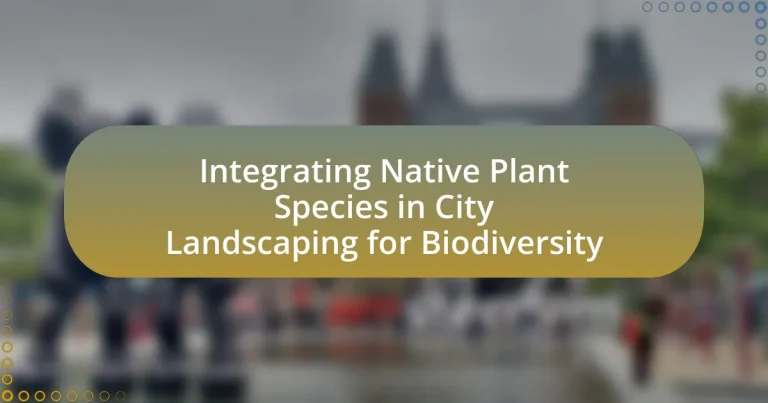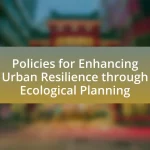Integrating native plant species in city landscaping is a crucial practice aimed at enhancing biodiversity and supporting local ecosystems. This article examines the ecological benefits of incorporating indigenous flora into urban environments, highlighting their role in providing habitats and food sources for wildlife, including pollinators and birds. It addresses the importance of native plants in promoting sustainable landscaping practices, the challenges faced in their integration, and effective strategies for successful implementation. Additionally, the article discusses the significance of community involvement, maintenance practices, and available resources for cities to foster long-term sustainability of native plant initiatives.

What is Integrating Native Plant Species in City Landscaping for Biodiversity?
Integrating native plant species in city landscaping for biodiversity involves incorporating indigenous flora into urban green spaces to enhance ecological health and support local wildlife. This practice promotes biodiversity by providing habitats and food sources for native pollinators, birds, and other wildlife, which are essential for maintaining balanced ecosystems. Research indicates that urban areas with native plants can support up to 50% more wildlife compared to those dominated by non-native species, as native plants are better adapted to local conditions and more beneficial to local fauna.
Why is integrating native plant species important for urban environments?
Integrating native plant species is important for urban environments because they enhance biodiversity and support local ecosystems. Native plants provide essential habitat and food sources for native wildlife, including pollinators like bees and butterflies, which are crucial for plant reproduction. Research indicates that urban areas with a higher proportion of native vegetation can support greater species diversity; for example, a study published in the journal “Ecological Applications” found that urban gardens with native plants had 50% more bird species compared to those with non-native plants. Additionally, native plants are better adapted to local soil and climate conditions, requiring less water and maintenance, which contributes to sustainable urban landscaping practices.
How do native plants contribute to local ecosystems?
Native plants contribute to local ecosystems by providing essential habitat and food sources for native wildlife. These plants support biodiversity by attracting pollinators such as bees and butterflies, which are crucial for the reproduction of many flowering plants. Additionally, native plants are adapted to local soil and climate conditions, promoting soil health and reducing the need for chemical fertilizers and pesticides. Research indicates that areas with a higher diversity of native plants can support a greater variety of animal species, enhancing ecosystem resilience and stability. For example, a study published in the journal “Ecological Applications” found that urban areas with native plant landscaping had 50% more bird species compared to those dominated by non-native plants.
What role do native plants play in supporting wildlife?
Native plants play a crucial role in supporting wildlife by providing essential food and habitat for various species. These plants are adapted to local environmental conditions, making them more resilient and beneficial for native fauna. For instance, native flowering plants supply nectar and pollen for pollinators like bees and butterflies, while native shrubs and trees offer shelter and nesting sites for birds and small mammals. Research indicates that landscapes dominated by native plants can support up to 50% more wildlife than those with non-native species, highlighting their importance in maintaining biodiversity.
What challenges exist in integrating native plant species into city landscaping?
Integrating native plant species into city landscaping faces several challenges, including limited public awareness, competition with invasive species, and maintenance issues. Limited public awareness can hinder support for native plant initiatives, as many residents may prefer traditional landscaping aesthetics. Competition with invasive species poses a significant threat, as these non-native plants can outcompete native species for resources, leading to reduced biodiversity. Additionally, maintenance issues arise because native plants may require different care than conventional landscaping, necessitating training for city workers and adjustments in landscaping practices. These challenges must be addressed to successfully enhance urban biodiversity through native plant integration.
What are the common misconceptions about native plants?
Common misconceptions about native plants include the belief that they require little to no maintenance, that they are unattractive compared to non-native species, and that they do not provide significant ecological benefits. While native plants are often more adapted to local conditions, they still require care, especially during establishment. Additionally, many native species offer unique beauty and diversity, contributing to aesthetic landscapes. Research indicates that native plants support local wildlife, including pollinators, more effectively than many non-native plants, enhancing biodiversity in urban settings.
How can urban planners overcome barriers to implementation?
Urban planners can overcome barriers to implementation by fostering collaboration among stakeholders, including government agencies, community organizations, and residents. This collaborative approach ensures that diverse perspectives are considered, leading to more comprehensive planning and increased public support. For instance, successful projects like the Green Streets Initiative in Seattle demonstrate how engaging local communities in the planning process can enhance acceptance and facilitate the integration of native plant species in urban landscaping. Additionally, securing funding through grants and public-private partnerships can provide the necessary resources to implement these initiatives effectively.
What strategies can be employed for successful integration?
Successful integration of native plant species in city landscaping can be achieved through strategies such as community engagement, ecological planning, and adaptive management. Community engagement involves educating residents about the benefits of native plants, fostering a sense of ownership, and encouraging participation in planting and maintenance efforts. Ecological planning requires assessing local ecosystems to select appropriate native species that will thrive in specific urban environments, thereby enhancing biodiversity. Adaptive management entails monitoring the performance of native plants and making necessary adjustments based on observed outcomes, ensuring long-term success. These strategies are supported by studies indicating that community involvement increases project sustainability and that ecological planning leads to improved habitat quality for local wildlife.
How can community involvement enhance native plant integration?
Community involvement enhances native plant integration by fostering local stewardship and increasing awareness of ecological benefits. Engaging residents in planting and maintaining native species creates a sense of ownership and responsibility, leading to more sustainable practices. Studies show that community-led initiatives, such as local gardening clubs or educational workshops, can significantly boost participation rates in native plant projects, resulting in improved biodiversity and habitat restoration. For instance, a project in Portland, Oregon, demonstrated that neighborhoods with active community participation saw a 30% increase in native plant survival rates compared to areas without such involvement.
What are effective design principles for incorporating native plants?
Effective design principles for incorporating native plants include selecting species that are well-adapted to the local climate and soil conditions, ensuring biodiversity by using a variety of native plants, and creating layered plantings that mimic natural ecosystems. Research indicates that native plants support local wildlife, including pollinators, and enhance ecosystem resilience. For example, a study by the University of Delaware found that landscapes with native plants can support up to 50% more wildlife than those with non-native species. Additionally, incorporating native plants can reduce maintenance costs and water usage, as they typically require less irrigation once established.

How does integrating native plant species enhance biodiversity in urban areas?
Integrating native plant species enhances biodiversity in urban areas by providing essential habitats and food sources for local wildlife. Native plants are adapted to the local climate and soil conditions, which allows them to thrive without the need for excessive water or chemical fertilizers, thus supporting a diverse range of insects, birds, and other organisms. Research indicates that urban areas with higher proportions of native vegetation support greater species richness; for example, a study published in the journal “Ecological Applications” found that urban gardens with native plants had 50% more bird species compared to those with non-native plants. This increase in biodiversity contributes to ecosystem resilience, improves pollination services, and enhances the overall health of urban environments.
What specific benefits do native plants provide to urban biodiversity?
Native plants enhance urban biodiversity by providing essential habitats and food sources for local wildlife. These plants are adapted to the local climate and soil conditions, which allows them to thrive and support a diverse range of species, including pollinators like bees and butterflies. Research indicates that urban areas with a higher proportion of native vegetation can support greater species richness; for example, a study published in the journal “Ecological Applications” found that native plant gardens can increase pollinator diversity by up to 50% compared to non-native gardens. Additionally, native plants contribute to ecosystem services such as improved soil health and water retention, further promoting a balanced urban ecosystem.
How do native plants improve soil health and water retention?
Native plants improve soil health and water retention by enhancing soil structure and increasing organic matter. Their deep root systems aerate the soil, allowing for better water infiltration and reducing runoff. Studies show that native plants can increase soil organic carbon levels by up to 30%, which improves nutrient availability and microbial activity. Additionally, native vegetation reduces erosion and promotes the formation of soil aggregates, further enhancing water retention capabilities.
What impact do native plants have on pollinator populations?
Native plants significantly enhance pollinator populations by providing essential food sources and habitats. Research indicates that areas with a higher diversity of native flowering plants support greater numbers and varieties of pollinators, such as bees and butterflies. For instance, a study published in the journal “Ecological Applications” found that urban landscapes incorporating native plants can increase pollinator abundance by up to 50% compared to those dominated by non-native species. This increase is attributed to the specific adaptations of native plants that cater to local pollinator species, ensuring a reliable supply of nectar and pollen throughout the growing season.
How can cities measure the success of native plant integration?
Cities can measure the success of native plant integration by assessing biodiversity, ecological health, and community engagement. Biodiversity can be evaluated through species richness and abundance surveys, which indicate the variety of native species thriving in urban landscapes. Ecological health can be monitored by analyzing soil quality, water retention, and habitat connectivity, as these factors reflect the ecosystem’s resilience and functionality. Community engagement can be gauged through surveys and participation rates in native planting initiatives, which demonstrate public support and awareness. Studies, such as the one conducted by the University of California, found that urban areas with integrated native plants showed a 30% increase in local pollinator populations, providing concrete evidence of ecological benefits.
What metrics are used to assess biodiversity improvements?
Metrics used to assess biodiversity improvements include species richness, species evenness, and habitat quality. Species richness measures the number of different species in a given area, while species evenness evaluates the relative abundance of those species. Habitat quality assesses the health and functionality of ecosystems, often using indicators such as vegetation cover, soil health, and the presence of native species. These metrics provide a comprehensive understanding of biodiversity changes, supported by studies showing that increased native plant diversity correlates with higher overall ecosystem resilience and functionality.
How can citizen science contribute to monitoring efforts?
Citizen science can significantly enhance monitoring efforts by engaging the public in data collection and observation, thereby increasing the volume and diversity of information gathered. For instance, initiatives like the National Audubon Society’s Christmas Bird Count mobilize thousands of volunteers to record bird populations, providing critical data for tracking species trends and informing conservation strategies. This collaborative approach not only expands the reach of monitoring programs but also fosters community involvement and awareness regarding biodiversity, as evidenced by studies showing that citizen-collected data can be as reliable as that gathered by professionals in various ecological contexts.

What are the best practices for maintaining native plant landscapes in cities?
The best practices for maintaining native plant landscapes in cities include selecting appropriate native species, ensuring proper soil health, implementing efficient irrigation techniques, and managing invasive species. Selecting native species that are well-adapted to local conditions enhances resilience and reduces maintenance needs. Healthy soil, enriched with organic matter, supports plant growth and biodiversity. Efficient irrigation techniques, such as drip irrigation, minimize water waste and ensure plants receive adequate moisture. Regular monitoring and management of invasive species prevent them from outcompeting native plants, thereby preserving the ecological balance. These practices collectively contribute to sustainable urban ecosystems, promoting biodiversity and enhancing urban resilience.
How can cities ensure the long-term sustainability of native plant species?
Cities can ensure the long-term sustainability of native plant species by implementing comprehensive urban planning that prioritizes biodiversity. This includes creating protected areas, such as parks and green corridors, that support native ecosystems and facilitate the natural regeneration of local flora. Additionally, cities can promote the use of native plants in landscaping and public spaces, which helps to maintain genetic diversity and resilience against pests and diseases. Research indicates that urban areas with higher native plant diversity support greater populations of pollinators and other wildlife, enhancing overall ecosystem health. For instance, a study published in the journal “Ecological Applications” found that urban gardens with native plants significantly increased local biodiversity compared to those with non-native species.
What maintenance practices are essential for native plant health?
Essential maintenance practices for native plant health include regular watering, mulching, weeding, and monitoring for pests and diseases. Regular watering ensures that native plants receive adequate moisture, especially during dry periods, which is crucial for their growth and survival. Mulching helps retain soil moisture, suppress weeds, and improve soil quality as it decomposes. Weeding is necessary to reduce competition for nutrients and resources, allowing native plants to thrive. Additionally, monitoring for pests and diseases enables early intervention, which can prevent significant damage to native plant populations. These practices collectively support the resilience and vitality of native plants in urban landscapes, contributing to biodiversity.
How can cities adapt to changing environmental conditions while maintaining native landscapes?
Cities can adapt to changing environmental conditions while maintaining native landscapes by implementing green infrastructure, such as rain gardens and permeable pavements, which enhance stormwater management and support local biodiversity. These practices allow cities to manage increased rainfall and flooding, while also providing habitats for native species. Research indicates that integrating native plant species into urban landscaping can improve resilience against climate change impacts, as native plants are better suited to local conditions and require less maintenance. For example, a study by the University of Florida found that landscapes with native plants can reduce water usage by up to 50% compared to non-native landscapes, demonstrating both ecological and resource conservation benefits.
What resources are available for cities looking to integrate native plants?
Cities looking to integrate native plants can access a variety of resources, including local extension services, native plant societies, and online databases. Local extension services, often affiliated with universities, provide expertise on suitable native species for specific regions and guidance on planting and maintenance. Native plant societies offer educational materials, workshops, and networking opportunities for city planners and landscapers. Online databases, such as the USDA PLANTS Database and the Lady Bird Johnson Wildflower Center, provide comprehensive information on native plant species, including their ecological benefits and cultivation requirements. These resources collectively support cities in enhancing biodiversity through the integration of native plants in urban landscapes.
What organizations provide support and guidance for native plant initiatives?
Organizations that provide support and guidance for native plant initiatives include the Native Plant Society of North America, the Xerces Society for Invertebrate Conservation, and the U.S. Fish and Wildlife Service. The Native Plant Society of North America promotes the use of native plants through education and advocacy, while the Xerces Society focuses on the conservation of invertebrates and their habitats, often emphasizing native plant use. The U.S. Fish and Wildlife Service offers resources and programs aimed at restoring native plant communities to support biodiversity. These organizations collectively contribute to the promotion and implementation of native plant initiatives across various regions.
How can cities access funding for native landscaping projects?
Cities can access funding for native landscaping projects through various sources such as federal grants, state programs, and local initiatives. For instance, the U.S. Environmental Protection Agency offers grants specifically aimed at enhancing urban ecosystems, which can be utilized for native landscaping. Additionally, state departments of natural resources often have funding programs that support biodiversity initiatives, including the integration of native plants in urban settings. Local governments can also seek partnerships with non-profit organizations focused on environmental conservation, which may provide financial support or resources for such projects.
What practical tips can cities implement for successful native plant integration?
Cities can successfully integrate native plants by conducting thorough site assessments to understand local soil, climate, and ecological conditions. This foundational step ensures that selected species are well-suited to thrive in their specific environments, which is critical for promoting biodiversity. Additionally, cities should engage the community through educational programs that highlight the benefits of native plants, fostering public support and participation in planting initiatives. Research indicates that community involvement can significantly enhance the success of urban greening projects, as seen in the “Community Engagement in Urban Greening” study published by the University of California. Furthermore, cities should establish maintenance plans that include regular monitoring and adaptive management strategies to address any challenges that arise post-implementation. This proactive approach is essential for sustaining native plant populations and maximizing their ecological benefits over time.


